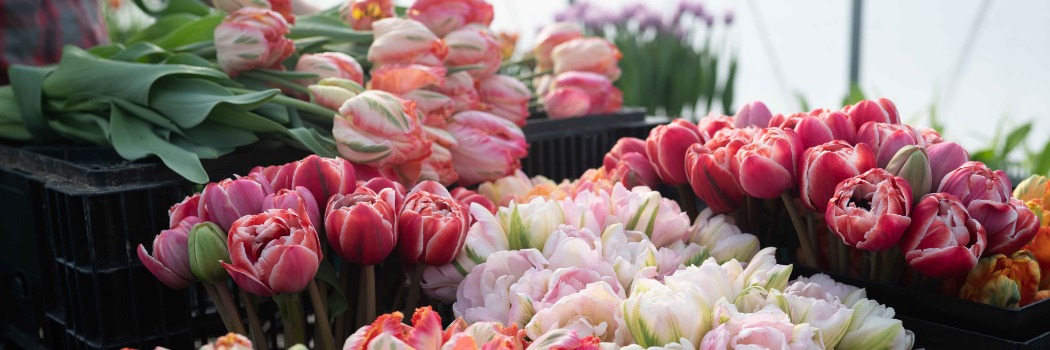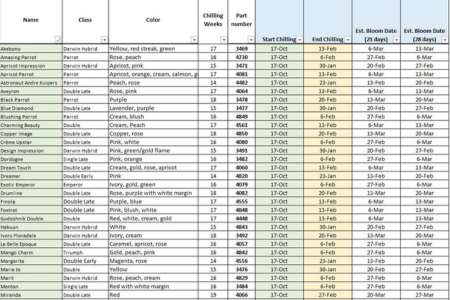- Tulip (Tulipa) Bulb Varieties | Comparison Chart (PDF)
- Tulip (Tulipa spp) | Key Growing Information
- Tulip & Narcissus Production Guide | Tech Sheet (PDF)
- Video: Overwintering Tulips in an Unheated Tunnel
- 'Finola' Double Late Flowering Tulip
- Video: 'Queensday' Tulip | from Johnny's Selected Seeds
- Tulip Harvesting: Tips & Recommendations
- 'Drumline' Double Late Flowering Tulip
- Video: 'Marie Jo' Tulip from Johnny's Selected Seeds
- 'Sensual Touch' Double Late Flowering Tulip
- 'Queen of the Night' Single Late Tulip
- 'Amazing Parrot' Apricot-Colored Parrot Tulip
- 'Dream Touch' Double Late Flowering Tulip
- 'Sunset Tropical' Double Late Flowering Tulip
- 'Astronaut Andre Kuipers' Tulip
- 'Foxtrot' Fragrant Double-Late-Flowering Tulip
- 'Marit' Darwin Hybrid Single Tulip
- 'Charming Beauty' Double Late Flowering Tulip
- 'Parrot King' Tulip
- 'Apricot Parrot' Tulip
- Video: 'Margarita' Tulip from Johnny's Selected Seeds
- Video: Darwin Hybrid Tulips from Johnny's Selected Seeds
- Video: 'Exotic Emperor' Tulip | from Johnny's Selected Seeds
- 'Verona' Double Early Flowering Tulip
- 'Menton' Single Late-Flowering Tulip
- 'Silver Cloud' Triumph Tulip
- 'Black Parrot' Late-Flowering Parrot Tulip
- 'Crème Upstar' Double Late Flowering Tulip
- Cut-Flower Harvesting & Post-Harvest Care | Best Practices from Pros in the Slow Flower Community
- Chrysal Clear Bulb Flower Conditioner | SDS
- Chrysal Clear Bulb T-Bag | Cut-Flower Conditioner | SDS
- Calculator - Bloom Date & Chilling Date for Forced Tulips | Johnny's Selected Seeds
- Introduction to Forcing Flower Bulbs in Soil | Guide to Forcing Flower Bulbs
- 'Mondial' Tulip from Johnny's Selected Seeds
- Forcing Tulip Bulbs | Guide to Forcing Flower Bulbs
- 'Dordogne' Tulip from Johnny's Selected Seeds
- Choosing Tulip Varieties for Forcing | Guide to Forcing Flower Bulbs
- Planting Tulip & Narcissus Bulbs at the Johnny's Research Farm
Choosing Tulip Varieties for Forcing
By Joy Longfellow, Flower Trial Technician
Scheduling Tips and Succession Planting Strategies for Forced Tulips
Scheduling your plantings for a full season of forced blooms can be a puzzle. There are two different strategies for achieving an extended season:
Choose several varieties with different chilling requirements and plant them in crates at the same time.
Varieties that require 14 weeks of chilling will be removed earlier than varieties that require 15 or 16 weeks and will therefore bloom earlier. For example: ‘Margarita’, ‘Mondial’ and ‘Verona’ require 14, 15, and 16 weeks of chilling time respectively. If planted all on the same date, ‘Margarita’ will be removed from cold storage first, after 14 weeks, and will flower first. ‘Mondial’ will be removed a week later, and ‘Verona’ a week after ‘Mondial’.
Crate the same varieties each week for several weeks.
If you want a single variety continuously through the season, start crates of that variety every week for several weeks. For example: ‘Verona’ requires 16 weeks of chilling time. If you want to harvest ‘Verona’ for four consecutive weeks in the spring, schedule plantings of ‘Verona’ every week for four weeks in the fall.
Managing Stem Quality in the Forcing Environment
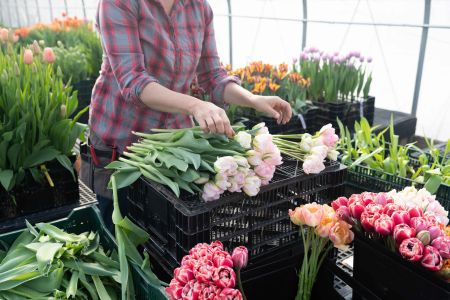
- Varieties that tend to force well typically have sturdy stems and a stocky plant habit. If a variety is tall and thin-stemmed in the field, it will likely perform similarly in a forcing environment, and possibly even more so since the plants will be grown in a sheltered greenhouse environment rather than in an open field where plants experience the stress of wind, rain, and fluctuating temperatures.
- Short, stocky varieties tend to be sturdy. For this reason, many double-flowering varieties that tend to be short are a good option for forcing.
- Early-season forcing: since greenhouse temperatures tend to be cooler and light levels are lower in the early season, varieties will develop more slowly and will have more time to elongate before flowering. For short varieties, we have observed longer stems when forced earlier in the season. If you are growing short varieties in your forcing program, you may achieve longer stem length by growing them earlier in the season rather than later.
- Later-season forcing: warmer greenhouse temperatures and higher light levels will promote faster growth and flowering the later you go into the season.
If forcing the same variety at different times in the season, be aware that stem lengths may differ and varieties that tend to be short may be even shorter when forced late in the season, as warmer temperatures may hasten flower development and provide less time for stem elongation. If you are growing very short varieties in your forcing program, they may be more likely to have acceptable stem lengths if forced earlier in the season rather than later, when cool temperatures slow flowering.
Variety Notes and Recommendations
While any variety can be forced to bloom earlier, some classes of tulips and varieties are better suited for forced cut-flower production. You will likely need to do your own research to develop a program of varieties that suits your growing environment and your markets.
| Johnny's 2023 Forced Tulip Trial Results | ||||
|---|---|---|---|---|
| Variety | Class | Chilling Weeks Required | Field Notes | |
| Akebono | Darwin Hybrid | 16 | Very long thin stems. Necks tend to snap and droop, more so than in field plantings. | |
| Apeldoorn's Elite | Darwin Hybrid | 19 | Shorter and smaller compared to the Impression Series but otherwise performance consistent with variety description. | |
| Apricot Impression | Darwin Hybrid | 15 | Uniform, tall, vigorous. Large leaves make harvesting and processing more time-consuming but otherwise good performance. | |
| Pink Impression | Darwin Hybrid | 15 | Uniform, tall, vigorous. Large leaves make harvesting and processing more time-consuming but otherwise good performance. | |
| Red Impression | Darwin Hybrid | 15 | Uniform, tall, vigorous. Large leaves make harvesting and processing more time-consuming but otherwise good performance. | |
| World's Favorite | Darwin Hybrid | 16 | Excellent color and bloom quality on thin stems. While stems tend to be thinner than the Impression Series, they are sturdier than Akebono. | |
| Charming Beauty | Double | 18 | Excellent stem and bloom quality. Stems tend to be shorter when forced later in the season. | |
| Gudoshnik Double | Double | 15 | Tall stems, healthy plants, fully double blooms but necks are weak and not able to fully support the large blooms. Better performance in field plantings. | |
| Marie Jo | Double | 15 | Flowers on short but uniform stems with good bloom quality. | |
| Margarita | Double Early | 14 | Excellent color, bloom and stem quality. | |
| Verona | Double Early | 16 | Versatile color for late winter and early spring. Good stem and bloom quality. Excellent overall performance, although stems are a little short especially in later successions. | |
| Crème Upstar | Double Late | 17 | Beautiful color and sturdy stems. Flowered faster and on shorter stems in later successions. Yielded tallest stems in early successions. | |
| Dream Touch | Double Late | 17 | Straight stems are easy to clean. Excellent overall. Best performance in earlier successions—flowers faster and on shorter stems in later plantings. | |
| Drumline | Double Late | 18 | Tall, clean stems, minimal foliage, uniform bloom time. Overall excellent quality. | |
| Finola | Double Late | 17 | Overall a strong variety. Good height, sturdy stems, good bloom quality, uniform development. Slightly shorter stems in later succession. | |
| Miranda | Double Late | 20 | Requires long chilling time and performace is variable. Slow to flower and not as uniform or reliable performance as field planting. | |
| Queensday | Double Late | 17 | Full double blooms. Thick stems. Excessive foliage—large leaves take more time to process. Great color and uniform stand. Flowers faster in later successions. | |
| Sunlover | Double Late | 15 | Slow to elongate and flower. Tall stems are not strong enough to support heavy double flowers. Performed better for us in field plantings. | |
| Amazing Parrot | Parrot | 18 | Stunning color. Sturdy stems. Necks may have a tendency to snap. | |
| Apricot Parrot | Parrot | 16 | Excellent quality. Large blooms. Long stems are easy to clean. Stems are long and clean and not as sturdy and stiff as varieties like Verona or Finola. | |
| Astronaut Andre Kuipers | Parrot | 17 | Highly uniform, sturdy stems, easy to harvest and clean. | |
| Mysterious Parrot | Parrot | 16 | Excellent quality. One of the best parrots for stem quality—thick stems don't droop and support flowers well. | |
| Parrot King | Parrot | 16 | Stunning color. Uniform blooms are good quality. Long stems are thin and may have a tendency to droop. | |
| Rasta Parrot | Parrot | 17 | Stems are short but are also very sturdy, straight and easy to harvest and clean. Blooms are consistent with field quality—not exceptionally full but striking colors. Shorter stems in later succession. | |
| Super Parrot | Parrot | 16 | Large, full blooms on weak stems that tend to snap/droop and are difficult to handle. Shorter stems in later succession. | |
| Dordogne | Single Late | 18 | Tall and slow to mature, with stems that tend to bend as blooms mature. | |
| Menton | Single Late | 16 | Tall and slow to mature. Gorgeous color, very tall. Necks tend to snap very easily after harvesting. | |
| Queen of the Night | Single Late | 17 | Slow to mature. Dramatic color, unique bloom shape, thin stems. | |
| Silver Cloud | Triumph | 17 | Stunning color, especially on developing buds. Elegant streamlined shape. Streamlined leaves also extend around bud and give some attractive contrast. Stems are thin and blooms are small but color is stunning and bloom shape is unique, adding interest to mixed bunches. | |
Notes on Tulip Classes
Tulip varieties for forcing can be found in all of the more well-known classes of tulips—Single Early, Double Early, Triumph, Darwin Hybrids, Parrots, Lily-flowering, Single-Late and Double-Late classes.
Darwin Hybrid Tulips
Darwin Hybrid tulips are generally tall and early, with good plant vigor. While these varieties are strong performers in the field, their long stems can have a tendency to be weak in a forced environment, so it is worth doing your own trialing of Darwin hybrids varieties.
- The Impression varieties have forced well in our trials, although plants do produce abundant vegetation which can slow down processing of cut stems.
Single Early Tulips
These classic single-flowering bulbs tend to be earlier to flower and are often selected for forcing early in the season.
Triumph Tulips
Triumph tulips are another class that is common for forcing. Triumph tulips are available in a wide range of colors and are primarily single-flowering. Triumph tulips offer more compact plant than the Darwin Hybrids, but are still taller compared to many double-flowering varieties.
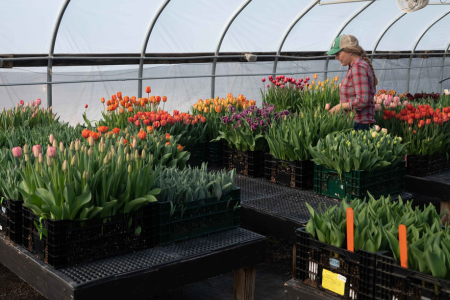
Double-Flowering Tulips
Both early and late-flowering double flowering tulip varieties often tend to be on the shorter side but offer a beautiful range of unique colors and flower forms. While stems can be short, they tend to be sturdy making harvesting and processing easier. Some varieties that have performed well in our trials are:
Parrot Tulips
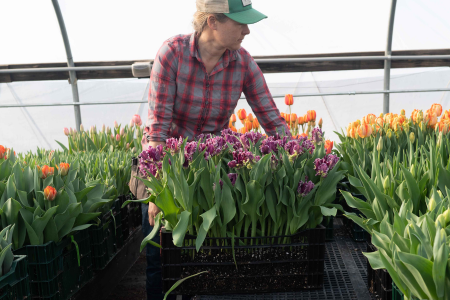
Parrots are a diverse class of tulips that offers fancy blooms in stunning color combinations. Characterized by their scalloped and ruffled petal edges, Parrot tulip varieties vary widely in flowering time, stem quality and color. Some of the strongest performers in our trials are:
- Rococo
- Rasta Parrot
- Mysterious Parrot
See our Forced Tulip Trial Results chart, above for more detailed information on other parrot tulip varieties.
Single Late
Also known as ‘French Tulips’ these single-flowering varieties tend to flower later in the season and on taller stems. Growers should trial their own favorite varieties.
References
- Hertogh, A. D. (1996). Holland Bulb Forcer's Guide. Hillegom, The Netherlands: The International Flower Bulb Centre.
- International Flower Bulb Centre. (2022). The Forcing of Tulips: Forcing methods for cut flower production and for pot plant production.
- Miller, D. W. (2010, November). A Review of Procedures for Forcing High Quality Rooting Room Bulbs. Retrieved from Research Newsletter: http://hort.cornell.edu/bulb/newsletter/pdfs/25-201011.pdf


